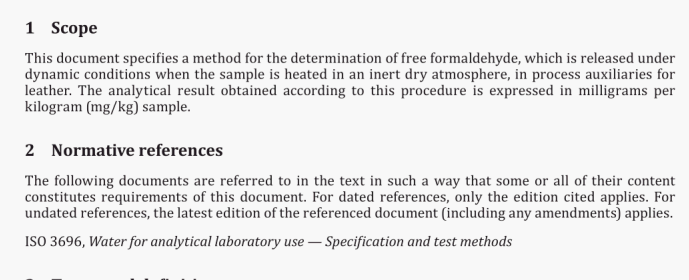Chemical tests

BS EN ISO 27587:2021 pdf free.Leather一Chemical tests – Determination of free formaldehyde in process auxiliaries.
Prepare a sample preparation system as described in Li. Initially, the U-tube (f4) and the DNPH cartridge (5J.2) are disconnected from the sampling system. All the parts of the sample preparation system shall be dry prior to use. Add 3 g to 4 g of sea sand (8) to the U-tube (f4), ensuring that it is not blocked and that the nitrogen flow can be maintained. Connect the U-tube and purge the system for 15 mm with nitrogen (6.3) at a flow rate of 500 mI/mm. It is important that the analysis be carried out under an inert atmosphere. The sampling system is slightly pressurized; therefore, all stopcocks should be secured with joint clamps.
7.3 Sample preparation
Accurately weigh 0,1 g to 2 g of sample to the nearest 0,001 g into the U-tube. It may be necessary to reduce the amount of sample if it is in a liquid phase to diminish the likelihood of condensed water giving erroneous results. The sample shall not be diluted. lithe sample contains an amount of formaldehyde higher than 80% of the cartridge capacity, either reduce the sample, increase the number of cartridges to be loaded in series (see £1.2) or do both. Apply a thin layer of stopcock grease (6.9) to the joints of the U-tube.
For each sample, restore the initial conditions (U).
In the case of a series of similar samples (different batches from the same production), the procedure of
purging with nitrogen may be reduced to 5 mm after the first sample.
7.4 Analysis
Introduce the DNPI-I cartridge (512), place the U-tube into the oil bath (6.1) preheated to (90 t 3) °C and check the flow rate of nitrogen (350 mI/mm to 150 mI/mm). The U-tube and cartridge shall be covered with aluminium foil to protect them against heat loss,
The U-tube shall be immersed in the oil bath until level A indicated in Figure 1. During sampling, it may be necessary to readjust the flow rate. Check that the temperature is (90 ± 3) °C. After 30 mm, remove the U-tube containing the sample from the oil bath. Remove any condensate from the cartridge side of the tubing and stopcock using a hair dryer (&.12). This step shall be carried out irrespective of whether condensate can be observed.
Remove the DNPH cartridge from the system. Collect the content of all the cartridges in a unique flask and elute it with small portions of acetonitrile (51.3) in a 10-mi volumetric flask or a higher volume, depending on the number of cartridges used. Make up to volume with acetonitrile.
Carefully mix the solution by shaking and filter an aliquot for analysis using a syringe filter (2j. Analyse the resulting filtrate by HPLC (LW).
It is recommended that the cartridges be removed from the refrigerator immediately prior to use. Experiments have shown that cartridges should be eluted within 3 days.
8 HPLC conditions
Various types of high-performance liquid chromatographic equipment can be used. Guidelines for suitable HPLC chromatographic conditions for this analysis are given in Annex B.
9 Calibration
Calibration is carried out by means olan external standard in the range ofO,5 g/W ml to 100 pg/b ml.
Prepare adequate dilutions (in acetonitrile) of the formaldehyde-2,4-DNPH analytical standard (5á). In each of six 10-mi volumetric flasks (6J.3), add 2 ml acetonitrile (51.3), then add an adequate quantity of derivatized DNPH-formaldehyde to ensure 0,5 pg; 2,0 pg; 5,0 pg; 20,0 jig; 50,0 jig; and 100,0 tg, respectively, of formaldehyde.
Fill the flasks up to the mark with acetonitrile and mix. After 60 mm, analyse the samples using HPLC after filtration through a membrane filter (1). Effect the calibration through plotting a graph of the formaldehyde derivative peak area versus the concentration in micrograms per 10 ml.
10 Calculation
Calculate the formaldehyde content (w) expressed in milligrams per kilogram (mg/kg) of sample being tested, as in Formula (f).
11 Checking reagents for absence of formaldehyde
Blank analyses should be carried out on a regular basis and at least for each lot of reagents, mobile phase and cartridges or any other change in the system.
The formaldehyde content detected in the blank solution should be below 75 % of the lowest calibration level (0,5 g/1O ml).
12 Control of the procedure
Spike the sea sand within the U-tube with 250 pI of formaldehyde solution S2 (MI). Proceed as described in 74. Calculations are carried out as described in Clause 10. A minimum recovery rate of 90 % shall be calculated. In the event of lower levels being detected, possible sources of error shall be detected and eliminated prior to routine analysis of samples.
13 Determination of formaldehyde in solution SI
Pipette 10 ml of formaldehyde solution Si (5.10) into a 250-mI Erlenmeyer flask and mix with 50 ml of iodine solution (5.4) as well as with sodium hydroxide (5.2) until it turns to yellow. Allow it to settle for 15 mm at 18 °C to 30 °C and then add 15 ml sulfuric acid (M) while swirling.
After adding 2 ml of starch solution (55). titrate the excess iodine with sodium thiosulfate (5.3) until the colour changes. Make three individual determinations. Titrate a blank solution in the same manner, as in Formula (2).
The test report shall include the following:
a) a reference to this document (ISO 27587:2021);
b) the type, origin and designation of the analysed product and the sampling method used;
c) the analytical result for free formaldehyde content in milligrams per kilogram (mg/kg), rounded to one decimal place;
d) any deviation from the analytical procedure;
e) the date of the test.BS EN ISO 27587 pdf free download.Chemical tests